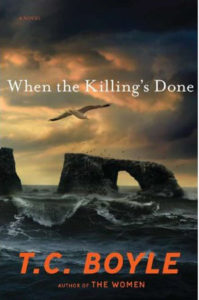Rats, feral pigs and eagles play important roles in T.C. Boyle’s thirteenth novel that’s based on real events that took place on the Northern California Channel Islands where an ecosystem — twisted by humans and introduced invasive species – has been struggling to survive for hundreds of years. Lonely and rugged, the islands are the backdrop for the continuing battle of man and nature in Boyle’s well-crafted, heart-felt story that doesn’t present typical bad guys/good guys or offer easy solutions.
Called the Galapagos of California, the Channel Islands feature wildlife and flora not found anywhere else on Earth. Its remote location is a Darwin-esque example of animals and plants adapting to their wind-swept environment, everyone an important link to each other’s survival.
Setting the stage, Boyle shows us just how devastated Anacapa Island was in the 1940s when a young woman is beached on the island after her boat sinks in an earthquake. She discovers that an infestation of rats (brought here from another boat wreck back in the Gold Rush days) have been running amok and destroying the indigenous wildlife for decades.
But rats are only the beginning of man’s influence –feral pigs, abandoned by farmers – have also been ruling the roost. Because of the rooting pigs, bald eagles have left the island and the charming Channel Island fox, once big man on island, is now relegated to lowly prey when golden eagles finds fox cubs are easy pickings.
Flash forward to more current times: the battle for the Islands is coming to a head with two ideological parties determined to win at any cost. The National Park Service wants to control the problem and bring the Islands back to its original state – and that means killing the rats and the pigs along with relocating the golden eagles. But there’s a militant animal rights’ group that opposes killing of any kind.
Personifying these two camps is Alma Boyd Takesure, a biologist for the Park Service, who has been given the task of poisoning the rats and eradicating the pigs. Her nemesis is Dave LaJoy who, with his gang of animal rights activists, seeks to sabotage Alma’s endeavors. Both present compelling arguments for their cause; both are flawed humans, both can be ruthless and yet tenderly sensitive. How much can we love animals, even when their destructive nature threatens so many other elements of life? Yet, what gives us the right to kill another living creature?
Boyle gives us fodder to ponder these big questions as the undercurrent of a crispy-told, often-tense story that’s chock-full of humor, keen detail and characters we actually care about. While the story involves a complex issue, and there are plenty of killings, Boyle presents a tale that is haunting with its history and emotion while itquestions humanity’s impact on the natural world around us.
— Brenda Rees, editor

